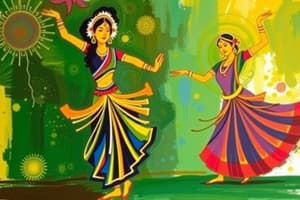Podcast
Questions and Answers
What is the Natya Shastra?
What is the Natya Shastra?
- A religious text
- A type of Indian classical dance
- A Sanskrit dictionary
- The foundational treatise for classical dances of India (correct)
How many classical dances are recognized by the Sangeet Natak Akademi and the Ministry of Culture?
How many classical dances are recognized by the Sangeet Natak Akademi and the Ministry of Culture?
- Ten (correct)
- Eight
- Fifteen
- Twelve
What are the three categories of performance in the Natya Shastra?
What are the three categories of performance in the Natya Shastra?
- Sattvika, Aharya and Nritya
- Nritta, Nritya and Natya (correct)
- Mudra, Hasta and Pantomime
- Angika, Vachika and Aharya
What is abhinaya?
What is abhinaya?
What are the four aspects of a performance in Hindu classical dances?
What are the four aspects of a performance in Hindu classical dances?
What is the significance of mudras or hastas in Indian classical dances?
What is the significance of mudras or hastas in Indian classical dances?
What is the purpose of Indian classical dances?
What is the purpose of Indian classical dances?
What is the origin of Indian classical dances?
What is the origin of Indian classical dances?
What is the Natya Shastra attributed to?
What is the Natya Shastra attributed to?
Flashcards
Indian Classical Dance
Indian Classical Dance
Performance arts rooted in Hindu musical theatre styles.
Natya Shastra
Natya Shastra
An ancient treatise on the performing arts, attributed to Bharata Muni.
Abhinaya
Abhinaya
Expressive gestures (mudras or hastas) and pantomime set to music.
Angika
Angika
Signup and view all the flashcards
Vachika
Vachika
Signup and view all the flashcards
Aharya
Aharya
Signup and view all the flashcards
Sattvika
Sattvika
Signup and view all the flashcards
Nritta, Nritya and Natya
Nritta, Nritya and Natya
Signup and view all the flashcards
Recognised Classical Dances
Recognised Classical Dances
Signup and view all the flashcards
Study Notes
Indian Classical Dance: A Summary
- Indian classical dance refers to various performance arts rooted in Hindu musical theatre styles.
- The number of classical dances range from eight to more, depending on the source and scholar.
- The Natya Shastra is the foundational treatise for classical dances of India, and this text is attributed to the ancient scholar Bharata Muni.
- While the Natya Shastra is the revered ancient text in the Hindu tradition, there are numerous other ancient and medieval Sanskrit dance-drama related texts that further discuss and expand on the classical repertoire of performance arts.
- Indian classical dances are traditionally performed as an expressive drama-dance form of religious performance art, related to Vaishnavism, Shaivism, Shaktism, pan-Hindu Epics and the Vedic literature, or a folksy entertainment that includes story-telling from Sanskrit or regional language plays.
- The classical dance forms recognised by the Sangeet Natak Akademi and the Ministry of Culture are Bharatanatyam, Kathak, Kuchipudi, Odissi, Kathakali, Sattriya, Manipuri, Mohiniyattam, and Chhau.
- All major classical Indian dance forms include in repertoire, three categories of performance in the Natya Shastra. These are Nritta, Nritya and Natya.
- All classical dances of India used similar symbolism and rules of gestures in abhinaya (acting).
- The roots of abhinaya are found in the Natyashastra text which defines drama in verse 6.10 as that which aesthetically arouses joy in the spectator, through the medium of actor's art of communication, that helps connect and transport the individual into a super sensual inner state of being.
- The communication through symbols is in the form of expressive gestures (mudras or hastas) and pantomime set to music.
- In Hindu classical dances, the artist successfully expresses the spiritual ideas by paying attention to four aspects of a performance: Angika (gestures and body language), Vachika (song, recitation, music and rhythm), Aharya (stage setting, costume, make up, jewelry), and Sattvika (the artist's mental disposition and emotional connection with the story and audience).
- Indian classical dancers usually dance to beat of the song or sound that is playing. They move their body to rhythm of the music and they flow.
Studying That Suits You
Use AI to generate personalized quizzes and flashcards to suit your learning preferences.




